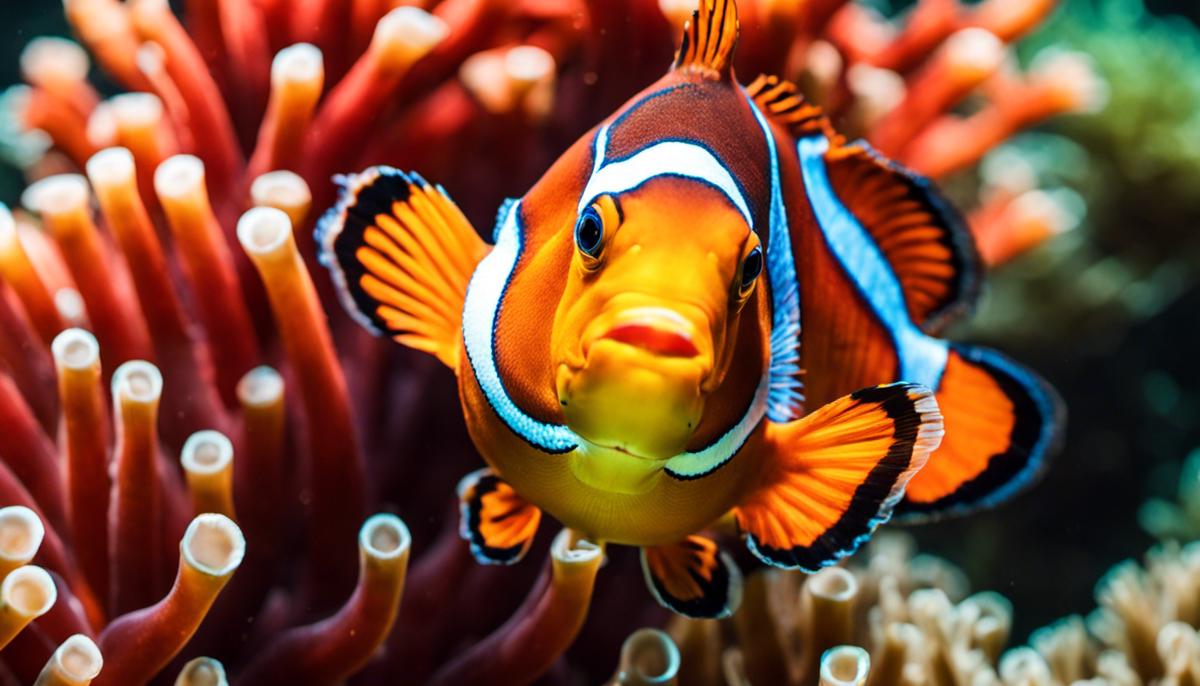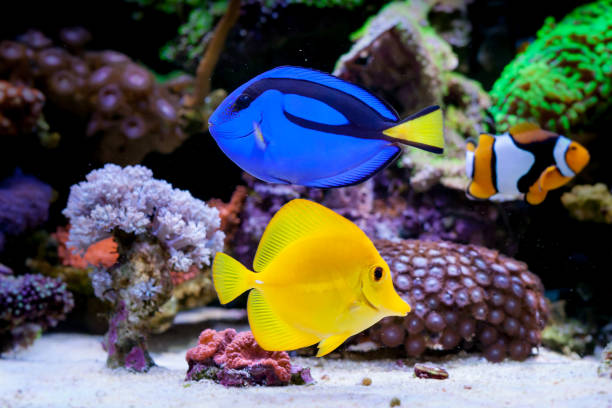Immersing oneself in the captivating world of aquatics can be a joy that presents a window into the aquatic world’s vibrant spectrum of colors. One of the most eye-catching elements that make an aquarium attractive and exciting is the diversity of vibrant fish species in it. Featured in this discussion are some of the most colorful fish that promise to add flair and animate any aquarium. From the rainforest elegance of the Mandarin Goby to the bold bright Flame Angelfish, the gleaming Yellow Tang, and the iconic Clownfish, each has unique features that brighten up and enhance your aquarium’s aesthetic appeal.
Mandarin Goby
Marvel at the Mandarin Goby: A Burst of Color in Your Aquarium
Meet the Mandarin Goby, also known as the Mandarin Dragonet, a spectacularly colorful species of fish that can add exuberance and vibrancy to any aquarium. Hailing from the Pacific, this little creature carries the allure of the rainforest right into your living room. Its body is a canvas painted in the liveliest of colors: blue, orange, and green.
The Mandarin Goby is a pocket-sized powerhouse of beauty, reaching just 4 inches when fully mature. But what the Mandarin Goby lacks in size, it more than makes up for in visual appeal. Its unique pattern of bright blue circular markings against a brilliant orange backdrop is nothing less than mesmerizing.
The Personality that Matches its Looks
As opposed to its flashy exterior, the Mandarin Goby boasts a calm and peaceful demeanor. It tends to be a slow swimmer and usually prefers to casually crawl over the substrate with its pelvic fins almost like a walking motion. This subtle, gentle movement further augments the Mandarin Goby’s elegance.
The beauty of the Mandarin Goby is not its only selling point as an aquarium fish. Despite their colorful allure, these fish are non-aggressive and coexist peacefully with a variety of other species. However, they are also quite shy and prefer to have plenty of hiding spots in the aquarium, lending the aquarium a sort of playful mystery.
Care and Maintenance
While the Mandarin Goby provides a visual treat, it’s essential to note that its care is not as simplistic as its swimming patterns. These fish have a notoriously picky diet primarily consisting of copepods and amphipods—tiny crustaceans that live in rockwork and substrate. The ideal habitat for Mandarin Gobies should be well-established with plenty of live rock for the crustaceans to flourish. Additionally, Mandarin Gobies are known to jump, so a well-secured lid is recommended for their aquarium home.
While the Mandarin Goby might require a bit more effort than your average freshwater fish, nothing can match the color and vibrancy it brings to an aquarium. The sight of this enchanting creature gracefully moving amid your tank flora makes the Mandarin Goby worth every bit of the care it needs. As an aquarium staple, it promises to capture attention and hearts with its spectacular display of colors and tranquil nature.

Flame Angelfish
A Splash of Color with the Flame Angelfish
One cannot overlook the Flame Angelfish when discussing colorful aquarium fish. It stands out with its intense hue and distinct markings. The dominant red body of the fish is beautifully contrasted by striking black vertical stripes. Coupled with a vibrant blue tail, the flame angelfish adds an incredible splash of color to any aquarium. This dainty species, native to the tropical waters of the South Pacific, typically grows to about 4 inches, making it a perfect fit for medium to large-sized tanks.
Not Just a Colorful Sight
Beyond the eye-catching aesthetics, a flame angelfish has a lively character that adds an extra dash of excitement to your fish tank. This species is characteristically an energetic swimmer, tirelessly darting in and out of aquarium decorations and swimming across the tank throughout the day. Fish enthusiasts can look forward to a vibrant and dynamic display that never fails to entertain.
Caring for Your Flame Angelfish
While the Flame Angelfish is a spectacular sight and a joy to observe, it does require a specific set of conditions in its habitat to thrive. It prefers a saltwater tank with plenty of rocky hiding places and live rock for grazing. This active swimmer also appreciates generous swimming space, so a larger aquarium of at least 70 gallons would be ideal. As for its diet, Flame Angelfish are omnivorous and thrive on a varied diet. Feeding them a combination of meaty foods, spirulina, marine algae, and high-quality angelfish preparations will keep them healthy and vibrant.
In consideration of all these characteristics, having a Flame Angelfish in your home aquarium promises to be a thoroughly enjoyable experience, adding both color and energy to your fishkeeping endeavor.

Yellow Tang
The Vibrant Yellow Tang: Brightening up Aquariums Worldwide
The Yellow Tang, scientific name Zebrasoma flavescens, truly lives up to its colorful name. Its body is a singular, vibrant yellow hue that remains consistent from youth to adulthood, giving it a perpetually cheerful aura, and making it indispensable in any marine aquarium setup. This Hawaiian native often shares its vivid coloration with the tropical sun of its original habitat.
Personality Traits: More Than Just a Pretty Face
Besides its striking appearance, the Yellow Tang has an equally lively personality that brings energy to any aquarium. Naturally sociable, these fish are active swimmers and are typically peaceful, co-existing well with other species. However, they can be territorial, especially when housed with other tangs. Providing ample swimming space is essential to maintaining a peaceful aquarium environment.
Diet: Omnivorous Species Delight
An Omnivore by nature, the Yellow Tang is easy to feed, which adds to its desirability for aquarium keepers, novice and experienced alike. They enjoy munching on marine algae, one of their favorite snacks, along with other dietary supplements such as brine shrimp. Their diet contributes substantially to their health and vibrant color, hence the importance of varied and nutritious offerings cannot be emphasized enough.
Habitat Requirements: A Slice of Ocean Life
Yellow Tangs require specific aquarium conditions to thrive. Start with a tank of no less than 100 gallons to replicate their open-water swimming habits. The water temperature should be maintained between 75-79°F with a pH level of 8.1-8.4. Remember that these species are natural reef dwellers, so providing them with an environment enriched with rocks and corals where they can graze and hide is advantageous to them.
Contrasting Beauty: A Pop of Yellow
One striking advantage of choosing to showcase a Yellow Tang in your home aquarium lies in its ability to hold its own, design-wise. The sun-like gleam of their bodies makes them a standout attraction, especially when contrasted against blue or dark backgrounds. Whether your aquarium takes the look of a deep-sea panorama or a vibrant reef setting, the Yellow Tang will always pull focus. It’s a little piece of tropical sunshine, swimming around right in your own home.
Popular and Easy to Find: Yellow Tang Availability
Thanks to their popularity, Yellow Tangs are not difficult to source. They are regularly available at pet stores, and aquarium trade shows, or can be purchased online. Despite their striking appearance, they are generally affordable. However, responsible sourcing is crucial as the collection of this species needs to be regulated to prevent the depletion of wild populations. Reputable retailers will confirm the species was acquired responsibly to ensure you’re contributing to the ethical care and keeping of these radiant creatures.

Clownfish
The Clownfish, or Anemonefish
The Clownfish, or Anemonefish, is the star of many aquariums thanks to their bold, bright colors and distinctive patterning. Characterized by their vibrant orange bodies, white stripes, and black outlines on their fins, these fish are delightfully appealing and easy to spot. They typically reach about 4.3 inches in length, making them a wonderful addition to a striking marine setup.
Aquarium Care and Requirements
Clownfish are hardy creatures that are suitable for both beginner and expert aquarists. They require a tank of at least 20 gallons with plenty of hiding spots. Once established, they are quite resistant to disease and cope well with changes in water parameters. Feeding Clownfish is simple since they are not picky eaters. They can consume a diet of frozen mysis shrimp, vitamin-enriched brine shrimp, and a high-quality omnivore pellet food.
Behavior and Compatibility
These fish are known for their sociable behavior and make great additions to a diverse aquarium. However, it’s essential to remember that Clownfish can be territorial, especially around their hosting anemone. Therefore, if planning to add them to a mixed-species tank, ensuring enough room is given to all inhabitants is critical.
Color Variants
Clownfish have distinctive color variations apart from their classic orange. Some are varying shades of yellow, while others may display a deep black base with vibrant color accents. There are also some designer breeds that show off different patterns and color mixes.
In conclusion
Clownfish, with their striking colors and dynamic behaviors, are an excellent choice for your aquarium, promising to add a vibrant splash of marine life right into your living room.

Infusing your aquarium with an array of colorful fish not only amplifies its beauty but also brings a piece of the wonders beneath the world’s oceans into your living room. Whether you’re enamored by the Mandarin Goby’s flamboyant colors, inspired by the Flame Angelfish’s fiery vibrancy, charmed by the vibrant Yellow Tang, or drawn to the charismatic and widely recognizable Clownfish, your aquarium is an avenue to showcase these vivid marvels of the sea. As you learn more about these species and potentially bring them into your own space, you’re not only engaging in a rewarding hobby but also appreciating the beauty and diversity of our planet’s aquatic life.
ChasingNemo.com is a participant in the Amazon Services LLC Some of the links in our posts are affiliate links. Click Here For Full Disclosure.







